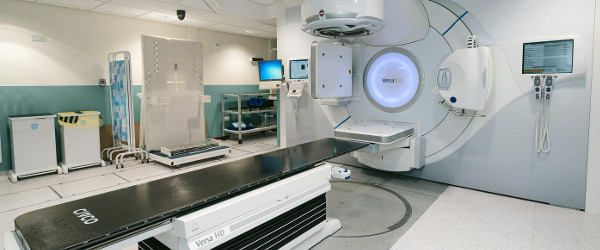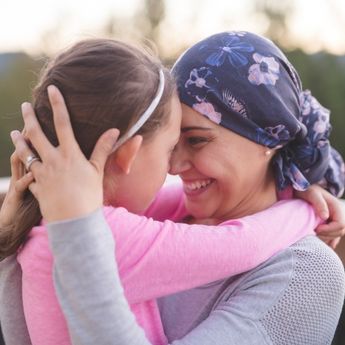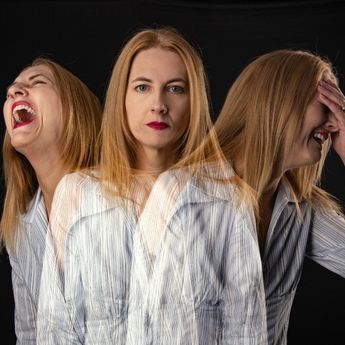By Adriana Ermter
In our monthly column, senior writer and editor Adriana Ermter shares her personal experiences with breast cancer.
Radiation therapy: two words that sounded surreal when I heard them attached to my cancer treatment plan. I knew what radiation was, technically, but I was clueless about what the actual experience would be like or how it would affect me. Mostly because my oncology team had described it and its potential side effects in vague terms.
Apparently, this isn’t unusual for women like me who’ve been diagnosed with breast cancer. A 2018 study published in the Journal of Cancer Education found that most women with a breast cancer diagnosis have a healthy dose of fear, mistrust and/or misconceptions about radiation treatment thanks to poor communication by healthcare providers. To help shine a little more light, here’s my version of what to expect when going through radiation therapy.
Radiation Explained
Radiation treatment helps reduce the chance of a breast cancer recurrence. There are different types of radiation including brachytherapy and external beam radiation therapy. Brachytherapy is an internal radiation used in some early-stage cancers and involves placing radioactive material inside or near the tumor site. The more common is external beam radiation therapy, which is what I had. It’s non-invasive and uses intense, high-energy rays (kind of like an X-ray), to kill cancer cells. A massive machine delivers the targeted radiation to the breast, chest wall, underarm and/or nearby lymph nodes.
My external beam radiation therapy sessions were quick and painless. I had them daily, Monday through Friday for three-ish months followed by a handful of “booster” (aka: extra) sessions at the end. The actual time I spent receiving radiotherapy was literally minutes-long with the lengthiest part being sitting in the waiting room and the set-up time for the treatment once I had my clothes off, gown on and was lying on my back, naked from the waist up on a freezing cold table. This was when the pushing and prodding would begin.
What Happens During Appointments
Radiation appointments are scheduled for the same time every day for consistency. Two to three technicians typically facilitated my appointments and each morning, they would greet me, hand me my protective eyewear and we’d get down to business.
One or two of the techs would work from an adjacent room with a glass window looking into the radiation room. From there, they’d call out a seemingly never-ending series of meridian-like coordinates—“Go to 42 North. Now 53 West. Oh, go back to 52 West…”—to the tech standing next to me. That tech would then pull, twist, shove and squish my right boob, armpit and the rest of my body into an uncomfortable contorted position until the tech behind the glass was convinced my alignment matched their coordinates. Once my body was clamped securely into place with equipment, the tech would remind me not to move before scurrying out of the room and closing the heavy metal door behind them. Safety tucked away with their colleagues behind the glass, the big machine hanging above me would whir into action—its invisible radiation beam quietly penetrating my body as it followed the GPS-like directions, all based on the blue-black dots newly tattooed on my skin.
Tattoos Mark the Radiation Spot
Yup, you have to get tattooed with a series of dots before you undergo radiation. Something that came as a huge surprise to me, since not one member of my oncology team told me this would happen. Despite my dots being the only tattoos I’ve ever received, getting them was weirdly underwhelming. It happened fast, during the early days of diagnosis, when I was still reeling from my new reality. I was bombarded with generalized breast cancer information, scrambling to overhaul my schedule to make room for a cancer-focused one, trying to hold it all together on the outside so I could still earn a pay cheque and do everything necessary to take care of myself, while freaking the fuck out on the inside.
The Physical Side Effects
While radiation doesn’t hurt in the moment, its cumulative side effects are brutal. For me, the worst were headaches, relentless fatigue and memory loss. And this wasn’t the "I stayed up too late binge-watching The Handmaid’s Tale" kind of tired—radiation fatigue is bone deep. It builds week by week, washing over you in unpredictable waves that can literally knock you off your feet. And no matter how much I slept, rest didn’t help. I was perpetually tired and I felt like memory had been scrubbed clean. My inability to retain even the tiniest scrap of information was maddening; I’ve never felt more useless or stupid.
I also had constant nausea and a fickle appetite. Foods I once loved suddenly made me gag. There were too many nights when I couldn’t bring myself to make dinner and I just crawled into bed instead.
Early on, my radiologist warned that after enough sessions, the treatment would feel like the worst sunburn imaginable. So, I asked if I could use sunscreen beforehand. As long as I applied a chemical-based option with broad-spectrum UVA/UVB protection, they said yes. Mineral-based sunscreens were a hard no—the zinc and other ingredients could interfere with the radiation. While maybe not an option for everyone—check with your care team before use—using sunscreen before each radiation session was a skin saver for me. Yes, my skin still burned, turning red, then darkening to a near-charred black, but it helped. The radiation techs commented daily on how healthy my skin looked and my radiologist echoed that in our weekly check-ins. I credit that to my consistent pre-treatment sunscreen use as well as slathering on Wellskin’s Base Glaxal cream afterwards. Because of my routine, my skin held up. No swelling. No open, weeping wounds.
While it doesn’t typically affect fertility; radiation also marked the end of any chance of pregnancy for me. I’d tried to get pregnant while married to my now ex-husband, but we weren’t lucky that way. My oncology team did discuss fertility preservation, like egg freezing before treatment, but freshly divorced and over 40, that option felt like a nonstarter. Like it or not, cancer made it heartbreakingly clear that I would never be a mom. Just one more facet of the emotional toll breast cancer and radiation took on me.
The Emotional Side Effects
No one really warns you about the emotional impact radiation can have. The relentless fatigue I mentioned, well, it also fogs your brain. It caused me to forget names, lose my train of thought mid-sentence and walk into rooms and wonder what I was doing there. I had to make list upon list to keep my thoughts straight. This never-ending exhaustion simultaneously made me feel like I looked old and haggard. Plus, I felt like I was disappearing because I was too tired to care about anything beyond surviving the day. When my months-long treatments ended, I continued to be heavily impacted by the cumulative effect radiation had on both my body and mind for the next two years. To be completely honest, my brain and memory have never bounced back 100 per cent. It’s a new normal, which I don’t like but I am accepting. Taking B12 as a daily supplement has definitely helped clear my brain, so ask your doctors if this may work for you.
There is comfort, though, in knowing radiation therapy is part of a standard treatment plan because it is effective. It has lowered my risk of recurrence, especially as it was combined with surgery, oral chemotherapy and hormonal therapy. Yes, it was a daily grind to keep showing up when my body ached and my spirits were six feet under the asphalt, but I don’t regret doing it. It made me feel more in control of my health and my life. Most of all, it has made me incredibly grateful to be here, to have made it this far despite being a member of the one-in-eight club of women who are diagnosed with breast cancer each year.
Adriana Ermter is a multi award-winning writer and editor. Her work can be read in IN Magazine, Living Luxe, 29Secrets.com, RethinkBreastCancer.ca and AmongMen.com. The former Beauty Director for FASHION and Editor-in-Chief for Salon and Childview magazines lives in Toronto with her two very spoiled rescue cats, Murphy and Olive. You can follow Adriana on Instagram @AdrianaErmter







